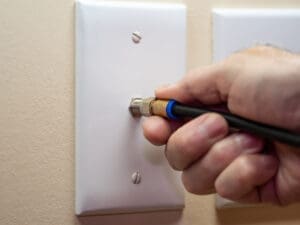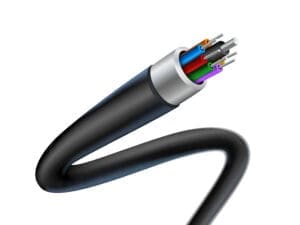Fiber vs. Coax: Why Fiber Benefits Your Business Most
Jul 3, 2024 | Business
It’s indisputable that a reliable and speedy internet connection is crucial for your business’s operations, communications, and overall efficiency. As technology evolves, business owners are faced with important decisions regarding their internet infrastructure. Two prevalent options are fiber-optic and coaxial (coax) cable internet. Understanding the differences between fiber vs. coax and the advantages of choosing fiber-optics can help business owners make informed decisions that will benefit their operations in both the short and long term.
Understanding Fiber and Coax: The Basics
Coaxial Cable
 Coaxial cable, often simply called coax, has been a mainstay in the telecommunications industry for decades. Originally designed for carrying television signals, coaxial cables consist of a central conductor surrounded by insulation, a metallic shield, and an outer insulating layer. This design protects the signal from external interference and allows it to travel long distances without significant degradation. That thick, round cord connecting your television or media system to the wall is a common example of communication via a coax cable. Coaxial internet often referred to as cable internet, utilizes the same infrastructure initially built for cable television. This technology transmits data over radio frequency (RF) signals, allowing for relatively high-speed internet access. However, because it shares bandwidth among multiple users in a neighborhood, performance can degrade during peak usage times. You’ll notice your upload or download speeds may vary considerably depending on the time of day when more residents in your area are accessing the internet.
Coaxial cable, often simply called coax, has been a mainstay in the telecommunications industry for decades. Originally designed for carrying television signals, coaxial cables consist of a central conductor surrounded by insulation, a metallic shield, and an outer insulating layer. This design protects the signal from external interference and allows it to travel long distances without significant degradation. That thick, round cord connecting your television or media system to the wall is a common example of communication via a coax cable. Coaxial internet often referred to as cable internet, utilizes the same infrastructure initially built for cable television. This technology transmits data over radio frequency (RF) signals, allowing for relatively high-speed internet access. However, because it shares bandwidth among multiple users in a neighborhood, performance can degrade during peak usage times. You’ll notice your upload or download speeds may vary considerably depending on the time of day when more residents in your area are accessing the internet.
Fiber-Optic Cable
 Fiber-optic technology represents a newer, more advanced form of data transmission. Unlike coax, which uses electrical signals, fiber-optics rely on light signals. A fiber-optic cable comprises strands of glass or plastic fibers, each about the diameter of a human hair. Data is transmitted through these fibers as pulses of light, allowing for incredibly high speeds and bandwidth capabilities. The construction of fiber-optic cables includes a core through which light signals travel, surrounded by cladding that reflects the light back into the core and an outer coating for protection. This design minimizes signal loss and interference, enabling data to travel over long distances with minimal degradation.
Fiber-optic technology represents a newer, more advanced form of data transmission. Unlike coax, which uses electrical signals, fiber-optics rely on light signals. A fiber-optic cable comprises strands of glass or plastic fibers, each about the diameter of a human hair. Data is transmitted through these fibers as pulses of light, allowing for incredibly high speeds and bandwidth capabilities. The construction of fiber-optic cables includes a core through which light signals travel, surrounded by cladding that reflects the light back into the core and an outer coating for protection. This design minimizes signal loss and interference, enabling data to travel over long distances with minimal degradation.
Key Differences Between Fiber vs. Coax
Speed and Bandwidth
One of the most significant differences between fiber-optic and coaxial internet is speed. Fiber-optics can deliver symmetrical speeds, meaning both upload and download speeds are equally fast. This capability is especially beneficial for businesses that rely on cloud services, video conferencing, and large file transfers. Typical fiber-optic speeds can range from 100 Mbps to 1 Gbps or higher. Hunter Communications offers business internet packages of up to 10 Gbps. In contrast, coaxial internet speeds are generally asymmetrical, with download speeds being significantly faster than upload speeds. While coax can offer high download speeds, often up to 1 Gbps, upload speeds are usually capped at much lower rates, which can be a limitation for businesses that require substantial upload bandwidth.
Reliability and Latency
Reliability is another critical factor in which fiber-optics outperform coax. Fiber-optic cables are less susceptible to environmental factors such as electromagnetic interference, weather conditions, and temperature fluctuations. This resilience translates to a more stable and consistent internet connection, reducing the risk of downtime and ensuring smooth business operations. Latency, or the time it takes for data to travel from its source to its destination, is generally lower with fiber-optic connections (which means data transmits faster!) This reduced latency is crucial for real-time applications like video conferencing, VoIP calls, and online gaming, where delays can severely impact performance and user experience.
Scalability and Future-Proofing
As businesses grow and their internet needs evolve, scalability becomes a vital consideration. Fiber-optic networks are inherently more scalable than coaxial networks. Upgrading a fiber network typically involves equipment upgrades rather than replacing the physical cables, making it easier and more cost-effective to increase capacity and support higher speeds as needed. Fiber-optics also offer a level of future-proofing that coaxial cables cannot match. With the continuous advancement of technology and increasing demand for high-speed internet, investing in fiber infrastructure ensures that businesses are well-prepared for future needs without frequent and costly overhauls.
Security
Data security is a paramount concern for businesses, especially in industries that handle sensitive information. Fiber-optic cables offer enhanced security over coaxial cables. Intercepting data transmitted through fiber-optics is considerably more challenging, as it requires physically tapping into the cable and detecting the light signals without breaking the connection. This difficulty makes fiber-optics a more secure option for businesses looking to protect their data from potential breaches and cyber-attacks.
Why Your Business Needs Fiber Internet From Hunter Communications
Enhanced Productivity
With the superior speeds and reliability of fiber-optic internet, businesses can experience enhanced productivity. Fast and consistent internet connections enable employees to perform their tasks more efficiently, whether they are uploading large files, conducting video conferences, or accessing cloud-based applications. The reduced downtime and fewer connectivity issues contribute to smoother workflows and higher overall productivity.
Improved Customer Experience
For businesses that interact with customers online, a fast and reliable internet connection is crucial. Slow loading times, buffering, and dropped connections can frustrate customers and harm the business’s reputation. Fiber-optics ensures a seamless online experience for customers, whether they are browsing a website, participating in a webinar, or engaging with customer support. This improved experience can lead to higher customer satisfaction and loyalty.
Cost Savings
While the initial installation cost of fiber-optic internet may be higher than that of coaxial cable, the long-term benefits often outweigh the upfront expenses. The reliability and lower maintenance requirements of fiber-optics can result in fewer service disruptions and reduced repair costs. Additionally, the increased efficiency and productivity enabled by faster internet speeds can lead to significant cost savings over time.
Competitive Advantage
Today, businesses depend on digital marketing and communication more than ever, so having a technological edge can make a substantial difference in achieving your goals. By adopting fiber-optic internet, businesses can gain a competitive advantage through improved operational efficiency, better customer service, and enhanced innovation capabilities. The ability to quickly adapt to new technologies and meet the growing demands of the digital marketplace positions businesses for long-term success.
Environmental Impact
Fiber-optic technology also offers environmental benefits. Fiber-optic cables are more energy-efficient than coaxial cables, requiring less power to transmit data over long distances. This reduced energy consumption contributes to a lower carbon footprint, aligning with sustainability goals and promoting eco-friendly business practices.
Ready to make the switch to Hunter Communications?
The choice between fiber-optic and coaxial internet is a critical decision for business owners seeking to optimize their operations and position themselves for future growth. While coaxial cable internet has served as a reliable option for many years, the superior speed, reliability, scalability, security, and overall benefits of fiber-optic technology make it the clear choice for businesses looking to stay ahead in the digital age. At Hunter Communications, we make moving to fiber internet easy for you. By choosing fiber internet, business owners can realize enhanced productivity, improved customer experiences, cost savings, competitive advantages, and a positive environmental impact. As the demand for high-speed internet continues to rise, making the switch to fiber-optics is not just a smart choice but a necessary one for businesses aiming to thrive in an increasingly connected world. Contact us today for more information.

